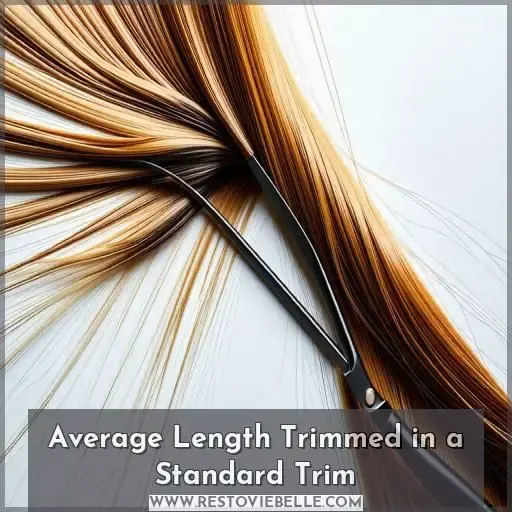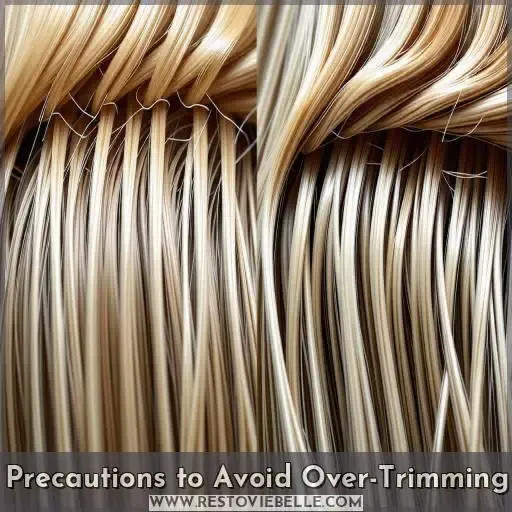This site is supported by our readers. We may earn a commission, at no cost to you, if you purchase through links.
 Don’t be misled—a standard trim only cuts off about 1/4 to 1 inch of hair!
Don’t be misled—a standard trim only cuts off about 1/4 to 1 inch of hair!
The amount trimmed depends on factors like your hair type, maintenance routine, split ends, and desired style.
Fine hair? 1/4 inch or less. Coarse hair? An inch or more might be needed.
With regular trims every 6-8 weeks, you’ll maintain healthy ends and shape. But severe split ends may require removing more length.
Trust your stylist’s recommendations based on their assessment of your hair’s condition and goals.
A small trim goes a long way in rejuvenating your locks—keep reading to learn more essential trimming insights.
Table Of Contents
- Key Takeaways
- How Much Hair is Cut Off in a Trim?
- Amount of Hair Removed in Trim
- Factors Influencing Trimming Length
- Average Length Trimmed in a Standard Trim
- Impact of Split Ends on Trimming Amount
- Variation in Trim Length Based on Hairstyle
- Considering Stylist Recommendations for Trim Length
- Precautions to Avoid Over-Trimming
- Managing Expectations for Trimming Results
- Frequently Asked Questions (FAQs)
- How many inches is taken off with a trim?
- How much is a trim off your hair?
- Is cutting 3 inches of hair a lot?
- How many inches to cut off dead ends?
- How often should I get a trim to maintain healthy hair?
- What are the signs that I need a trim?
- How much does a trim typically cost?
- Can I extend the time between trims with proper hair care?
- How does trimming differ from a dusting or haircut?
- Conclusion
Key Takeaways
- The amount of hair trimmed during a standard trim typically ranges from 1/4 to 1 inch, depending on factors like hair type, maintenance routine, split ends, and desired style.
- Regular trims every 6-8 weeks help maintain healthy ends and shape, while severe split ends may require removing more length based on the stylist’s assessment.
- Factors influencing trimming length include hair type, maintenance practices, and hairstyle, with stylists recommending trim amounts based on a thorough evaluation of hair condition.
- Avoiding over-trimming is important, and managing expectations is key, as regular trims help retain length by preventing split ends and breakage.
How Much Hair is Cut Off in a Trim?
The amount of hair cut off in a trim typically ranges from 1/4 inch to 1 inch, depending on factors like hair type and maintenance practices. Stylists assess hair condition and recommend a trim length to remove split ends and maintain healthy hair growth.
Amount of Hair Removed in Trim
When it concerns determining the amount of hair removed during a trim, split end types, trim frequency, and your hair care routine play principal roles.
Salon expertise directs the process, focusing on preserving healthy hair length, preventing damage, and ensuring a consistent hair care routine.
Comprehending the impact of split ends, the frequency of trims, and effective damage prevention measures are essential components of a successful hair care routine.
Embracing professional advice and expertise when it concerns hair trimming ensures the best results for maintaining healthy and attractive hair length.
Factors Influencing Trimming Length
Your hair type and maintenance practices noticeably influence how much length needs to be trimmed off during your next visit. For instance, coarse or curly hair that’s frequently heat-styled may require more frequent, slightly longer trims to remove damage and maintain shape.
Hair Type
Your hair type plays a key role in determining the ideal trim length. Fine, thin hair may only need a light dusting to remove split ends and maintain shape, while thick, coarse hair can handle more length removal. Curly or wavy hair often requires more frequent trims to prevent tangles and breakage. Consider these factors when deciding on your trim:
- Fine, thin hair: 1/4 inch or less
- Medium hair: 1/2 inch
- Thick, coarse hair: 1 inch or more
Communicate with your stylist about your hair type and desired look to achieve the perfect trim for your locks.
Maintenance Practices
In terms of maintaining the length of your hair during trims, your maintenance practices play a significant role.
Incorporating moisturizing products, sulfate-free shampoos, and bond repair treatments can help in preserving the health of your hair and minimizing the need for frequent trims.
Additionally, deep conditioning treatments and regular trims can work together to protect your hair from mechanical stresses, such as repeated combing, and prevent conditions like trichorrhexis nodosa.
These practices can form a protective layering that reduces the likelihood of split ends, contributing to the overall health of your hair.
Average Length Trimmed in a Standard Trim
The average length trimmed in a standard trim is typically around 1/4 to 1 inch, depending on your hair type and style.
Regular trims every 6-8 weeks help maintain your hair’s health and shape by removing split ends and damaged tips.
This small but frequent trim frequency allows you to retain length while keeping your hair looking fresh and polished.
Discuss your ideal trim length with your stylist, considering factors like your hair’s current condition, growth rate, and style goals.
Consistent trims promote hair elasticity and shine by preventing split ends from traveling up the hair shaft.
Impact of Split Ends on Trimming Amount
The amount of hair trimmed depends on the severity of your split ends.
If you have significant damage, your stylist may need to remove more length to eliminate frayed ends and protect your hair’s cuticle.
Regular trims every 8-12 weeks can prevent split ends from worsening and minimize the need for major length removal.
Maintaining your hair’s health with proper care and avoiding excessive heat styling will also reduce split ends and the amount of hair that needs to be trimmed off during your next visit.
Variation in Trim Length Based on Hairstyle
The amount of hair trimmed can vary considerably based on your hairstyle.
If you have layers or bangs, your stylist may need to trim those areas more frequently to maintain their shape and prevent split ends.
The length of your hair also plays a role – longer hair may require more trimming to keep it healthy and manageable.
Certain hairstyles, like blunt cuts or bobs, may need more precise trimming to maintain their sharp lines.
Heat styling with curling irons or blow dryers can also weaken your hair shaft, necessitating more frequent trims to prevent split ends and breakage.
Considering Stylist Recommendations for Trim Length
Your stylist’s recommendation on how much hair to trim off should be based on a thorough assessment of your hair’s condition. They’ll likely explain the benefits of removing damaged lengths to promote healthy hair growth and better styling.
Stylist Assesses Hair Condition
When evaluating your hair, a stylist considers its texture, historical care, and your future styling plans. They examine the hair shaft’s condition, looking for split ends and signs of hair maintenance. This evaluation makes certain that their technique aligns with your preferences and the health of your hair. By understanding your genetic conditions and hair style, the stylist can recommend suitable trim lengths, ensuring a balanced approach to the trimming process.
- Empower clients through informed decisions.
- Create a customized experience based on individual hair characteristics.
- Prioritize long-term hair health with personalized recommendations.
- Establish a positive and collaborative relationship for effective communication and shared vision. (Source)
Stylist Suggests Trim Amount
Your stylist will assess your hair’s condition and recommend a trim amount based on factors like split end severity, hair type, and your personal goals. They’ll suggest trimming just the damaged ends or a bit more to maintain your style. Trust their expertise – they know how to keep your hair healthy and looking its best.
Stylist Explains Trim Benefits
Your stylist will explain how regular trims:
- Prevent split ends and breakage
- Maintain your desired hairstyle
- Promote healthy hair growth
They’ll assess your hair’s condition and recommend a trim frequency based on your hair type and maintenance habits. Trimming removes damaged ends, refreshes your look, and keeps your hair in top shape between cuts. A quick trim is a simple way to keep your hair healthy and happy.
Precautions to Avoid Over-Trimming
While trims are essential for maintaining healthy hair, it’s important to avoid over-trimming.
Consult with your stylist to determine the ideal trim length based on your hair type, style, and condition.
Assess your hair at home between trims and use moisturizing products to minimize split ends.
If you notice excessive breakage or thinning, schedule an appointment to address the issue.
Managing Expectations for Trimming Results
While regular trims are essential for maintaining healthy hair, it’s important to manage your expectations. Trimming won’t make your hair grow faster, but it will help you retain length by preventing split ends from traveling up the hair shaft and causing breakage (Source). Aim for trims every 8-12 weeks, or when you notice:
- Split ends of varying lengths (Source)
- Difficulty combing through tangles
- Lack of shine and smoothness
Consult with your stylist to determine the ideal trim frequency for your hair type and lifestyle . With proper care and regular trims, you can enjoy long, healthy hair.
Frequently Asked Questions (FAQs)
How many inches is taken off with a trim?
A trim typically removes 1/4 to 1/2 inch of hair. You’ll maintain your desired length while rejuvenating your ends.
How much is a trim off your hair?
For a trim, stylists typically remove 1/4 to 1/2 inch of hair from the ends. This dusting maintains your style while freshening up your locks by removing split, damaged ends.
Is cutting 3 inches of hair a lot?
Snipping off 3 inches seems like an eternity for your luscious locks. It’s a major chop, reforming your hair’s shape – so think it through carefully before taking that plunge.
How many inches to cut off dead ends?
For healthy hair, trim just 1⁄4 to 1⁄2 inch off to remove split ends. Go easy—cutting more risks losing shape. With dead ends galore, cut up to 1 inch max, then return for regular trims.
How often should I get a trim to maintain healthy hair?
Your hair’s health is like a garden – regular trimming nourishes growth. Getting trims every 8-12 weeks helps remove split ends, for smooth, lustrous locks.
What are the signs that I need a trim?
You’ll know it’s time for a trim when your hair looks limp, frayed ends won’t stay smooth, and your style loses its shape. Pay attention to split ends, frizzy flyaways, and lack of movement – those signal it’s trim time!
How much does a trim typically cost?
A trim’s cost can range from a steal to a splurge, but typically hovers around $25-50 for a basic refresh. Of course, prices soar at high-end salons – yet an affordable option to keep your locks lovely.
Can I extend the time between trims with proper hair care?
Proper care extends trims. Avoid heat styling, use bond-repairing oils and deep conditioners to prevent breakage. With diligence, you can space trims 10-12 weeks apart.
How does trimming differ from a dusting or haircut?
An ounce of prevention saves nine: Regular trims maintain shape, while dustings remove frayed ends. But haircuts transform your look with length removal.
Conclusion
Envision your hair’s radiant shine after a professional trim.
While the amount of hair cut off in a trim depends on various factors like hair type and condition, your stylist’s expertise ensures desirable results.
By understanding trimming averages and following maintenance recommendations, you can maintain healthy, vibrant locks without sacrificing unnecessary length.
A small trim goes a long way in rejuvenating your mane.














